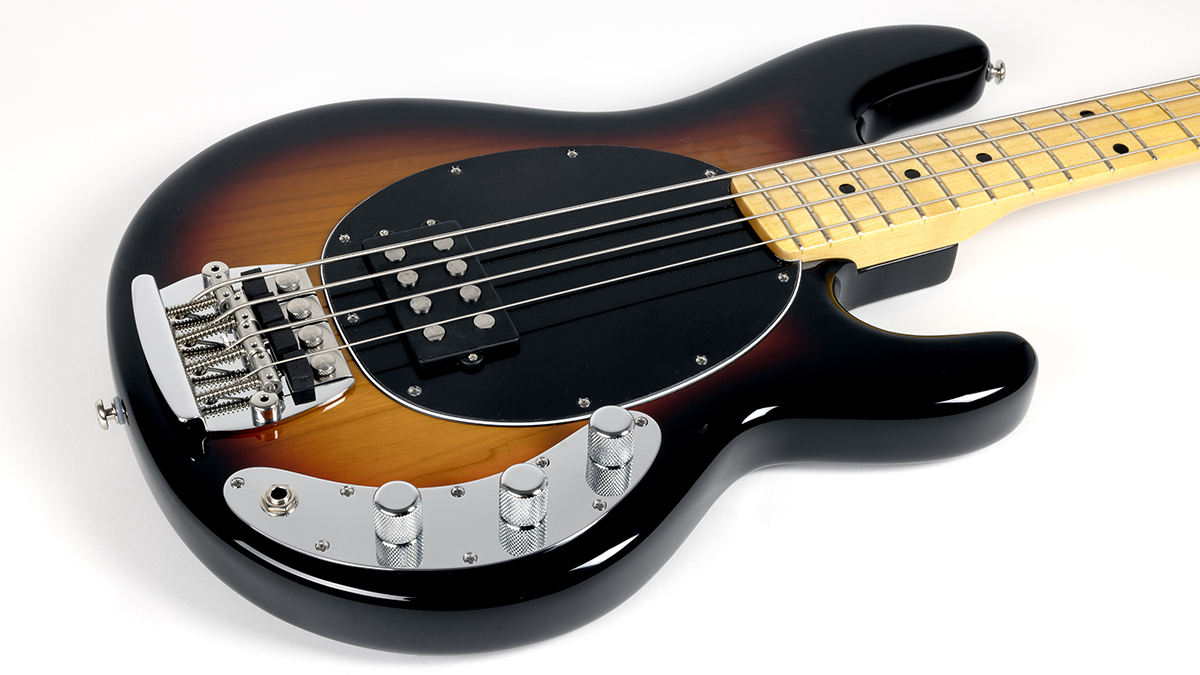Why the Ernie Ball Music Man StingRay remains a top choice for countless pro bassists
A look at the resilience of the Ernie Ball Music Man StingRay bass, arguably Leo Fender's final great design achievement.

The Music Man StingRay bass was arguably Leo Fender’s last great achievement. Introduced in 1976, the StingRay was the most successful instrument produced by Music Man, Leo’s first post-Fender venture, and was instantly embraced by a wide variety of popular and influential players. In essence, the StingRay was a modern update of the revolutionary Precision and Jazz Bass models Leo invented during the Fifties and Sixties, respectively, with much deeper bass, more aggressive and prominent midrange and brilliant treble that collectively produced bigger and seemingly three-dimensional tone that absolutely dominated a band’s bottom end.
The impact that the Music Man StingRay had on the world of bass cannot be understated, as it was instant and almost universal. Louis Johnson, one of the primary originators of funk slap bass technique, adopted the StingRay from the beginning, and his distinctive tone inspired players like Flea and Level 42’s Mark King to follow suit. Bernard Edwards’ prominent low-end Sting-Ray thump on Chic’s “Le Freak” influenced Queen’s John Deacon to adopt the StingRay (most notably for “Another One Bites the Dust”) along with Duran Duran’s John Taylor and many others. The StingRay also was a prominent fixture on hard rock concert stages, with dozens of players, including Aerosmith’s Tom Hamilton and Bad Company’s Boz Burrell, favoring its aggressive tone. The StingRay also was an important factor in the sound of new wave, disco, country, pop and even blues recordings during the mid Seventies through the Eighties.
The story of the StingRay bass easily could have ended in 1984 when the original Music Man company went out of business, but fortunately both the bass and the company were revived when Ernie Ball bought the business and paved the way for an entirely new and invigorated Music Man company. Ernie Ball Music Man CEO Sterling Ball was involved in the design of the original StingRay bass during the Seventies, providing Leo Fender and his cohorts valuable feedback and insight from a bass-playing musician’s perspective. His decision to purchase Music Man and take over production of the StingRay bass was as much a personal one as a business one.
“The StingRay was mostly the product of Leo and Tommy Walker’s engineering,” Ball says. “My constructive criticism helped them refine the final end product. I did beta testing for Leo, although we called it ‘bandstanding’ back then. I would play the StingRay at live gigs, and I’d also show it to different bass players to find out what they thought of it. Leo wasn’t a musician, so while his designs were often impressive from an engineering or structural standpoint, they didn’t always make the greatest sense from a player’s perspective. That’s what I brought to the StingRay’s design.”
The StingRay bass was the first instrument Ernie Ball Music Man produced, making its official debut in 1985. Initially the design of the StingRay continued where it left off, but soon Music Man introduced new refinements that further improved the StingRay’s performance and appeal. Some of those changes were brought about by Sterling Ball, designer Dudley Gimpel and Dan Norton, who built the first prototypes of the Ernie Ball Music Man StingRay, but many improvements and refinements were also brought about via feedback from artists.
“When we bought Music Man in 1984, my goal was to make tools for artists,” Ball says. “The StingRay bass was our first instrument, because that was the only Music Man product that musicians still accepted. I think Music Man’s success is mostly attributable to the fact that we really listen to the artists who play our basses and guitars. Trends constantly come and go in this industry. Music Man has survived two eras of pointy guitars and graphic finishes as well as the relic era. There are moments where the company was very hot, like we were with Keith Richards and Eddie Van Halen, and now we’re blazing hot once again with St. Vincent. But all through that we also always had close relationships with respected, timeless players like Steve Morse, Steve Lukather and John Petrucci. Over the years we have created the number one line of a living signature guitar player, and we’ve never discontinued a model.”

One of the most consistent supporters of the Music Man StingRay bass is Tony Levin, best known for his work with Peter Gabriel, King Crimson and hundreds of sessions. Levin first started playing a StingRay in 1979, and it has remained his main bass ever since. When Ernie Ball Music Man introduced the first five-string version of the StingRay in 1988, Levin was among the first to play it.
Get The Pick Newsletter
All the latest guitar news, interviews, lessons, reviews, deals and more, direct to your inbox!
“During the Eighties I realized I needed a low C or low B more often,” Levin says. “I tried a bunch of different five-string basses, but I found the low E string didn’t sound as big or fat as I wanted it to, and I rely on that low E string a lot. The low B string sounded big and fat, but the E didn’t. When Music Man came out with the StingRay 5, they sent me one to try out. I was skeptical at first, but lo and behold the E string had the punch I wanted. I could play blues in E on the five-string and still feel very good about the way it sounded. I still have that first StingRay 5, which has a peach-colored finish, so I call it my Barbie bass. I use it on about 70 percent of the things I do, and my other StingRays on another 10 to 15 percent. The rest is either Stick or upright.
“The StingRay sounds like a rock bass to me,” Levin elaborates. “Almost all of what I do is rock of some sort, whether it’s progressive or soft rock. It has punch. To my ears and my sensibilities as a bass player, the StingRay just has that. You don’t have to work to get that. When you’re thrown into new musical situations, it’s great to have a bass that sounds great by itself. If it’s not right, it’s usually because it needs something else like my upright or Stick. The StingRay sounds like the bass you want to have when you’re playing rock.”
Today Music Man offers a wide variety of StingRay bass models, including the StingRay, Classic and Neck-Through, all also available in five-string versions, as well as the “Old Smoothie” model produced in celebration of the Sting-Ray’s 40th anniversary. In celebration of the StingRay 5’s 30th anniversary, Music Man is producing a special model featuring a select roasted maple neck and fingerboard, Trans Buttercream finish, Red Tortoiseshell pickguard and a special anniversary humbucking pickup with ceramic magnet and soapbar cover.
The continuous refinements made to the StingRay design have attracted new generations of bass players to the model over the years. One recent convert is Stefan Lessard of the Dave Matthews Band, who switched to StingRay four-and five-string models in 2016.
“I wanted a new StingRay because I wasn’t getting the slap sound I wanted from the custom basses I own,” Lessard says. “I’m not really a slap player, but we were starting to experiment with some songs that required some slapping technique on the bass. When Music Man first sent me the StingRay, I really loved the tone. It has a lot of power, and I could get this really nice, warm R&B tone out of it, which is what I really strive for from my tone. The neck is super easy to play and adjust. I then asked them to send me a five-string, and Music Man sent me a neck-through model with this beautiful burgundy finish. The tone of that bass is just awesome. I get lows out of it that I struggle to get from my other basses. I fell right into it. I like experimenting with a lot of different basses, but these are just great, reliable working instruments.
“I have a lot of different toys to play with,” Lessard continues, “but it can get very confusing to have to change basses often during a show. I have to work out what each bass is going to sound like before every show, and that can be a big challenge. Now I just play a four-string and five-string StingRay bass, and we don’t have to make any adjustments because they sound exactly the same. The other four-and five-string basses I had before had totally different tonal characteristics. That can be cool, but for a live show I want something more consistent. I brought other basses out on tour with us, but I’ve only played the StingRays so far. Why change something when it’s so great?”
Chris is the co-author of Eruption - Conversations with Eddie Van Halen. He is a 40-year music industry veteran who started at Boardwalk Entertainment (Joan Jett, Night Ranger) and Roland US before becoming a guitar journalist in 1991. He has interviewed more than 600 artists, written more than 1,400 product reviews and contributed to Jeff Beck’s Beck 01: Hot Rods and Rock & Roll and Eric Clapton’s Six String Stories.
“An esoteric boutique vibe, superb ergonomics and a powerful, unique preamp – Tobias is back”: Tobias Growler IV review
“Affordable versions of the three best basses I've ever held in my hands”: Sterling by Music Man completes its trilogy of Joe Dart signature models with a trio of made-to-order basses that cost less than $500















